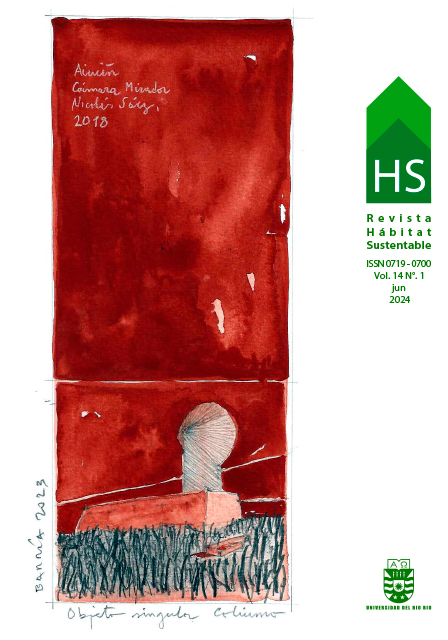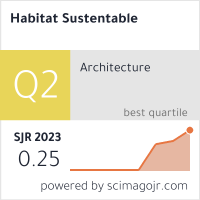Calificación de viviendas prefabricadas en madera basada en atributos de cumplimiento normativo, complejidad y sustentabilidad en Chile central
DOI:
https://doi.org/10.22320/07190700.2024.14.01.07Palabras clave:
viviendas de madera, ventas por internet, seguridad, sustentabilidadResumen
El estudio revisa los antecedentes publicados por fabricantes de viviendas prefabricadas en madera en Chile central. La metodología indaga en medios digitales de venta y servicio de impuestos internos. Utiliza los atributos de cumplimiento normativo-técnico, complejidad y sustentabilidad para calificar las viviendas prefabricadas en las regiones de Valparaíso, O’Higgins y Metropolitana. Un 83% de empresas son “constructoras-fabricantes”, 83% están legalmente constituidas. La complejidad revela que, para proyectos de mayor envergadura, 54% tienen nivel bajo, 35% nivel medio y 11% nivel alto. Hay debilidades en cumplimientos normativos y en información técnica para los potenciales clientes, siendo la sustentabilidad el atributo menos destacado, ya que pocas explicitan datos como huella de carbono, reciclaje de materiales o certificaciones voluntarias para diferenciarse en el mercado. Por tanto, se concluye que faltan acciones para potenciar a este sector productivo, con potencial de industrialización, incorporando gestión y reglamentación, con lo que disminuiría la inseguridad territorial por autoconstrucción
Descargas
Citas
BASCUÑÁN REYES, D. (2021). Tecnologías constructivas para la protección frente al fuego en edificios de madera de mediana y gran altura [Master's thesis, Universitat Politècnica de Catalunya]. http://hdl.handle.net/2117/349387
Biblioteca del Congreso Nacional de Chile. (BCN). (2023a). Resolución 59 EXENTA. Establece condiciones y mecanismos de aprobación de proyectos de viviendas industrializadas tipo y fija el procedimiento para revisión de proyectos que incorporen el uso de viviendas industrializadas tipo, desarrollados en el marco de los programas habitacionales fondo solidario elección de vivienda DS n°49 (V. Y U.) De 2011, y de habitabilidad rural DS n°10 (V. Y U.), de 2015. https://www.bcn.cl/leychile/navegar?i=1188149&f=2023-01-23
Biblioteca del Congreso Nacional de Chile (BCN). (2023b) Ley N° 21364 Establece el Sistema Nacional de Prevención y Respuesta ante Desastres, sustituye la Oficina Nacional de Emergencia por el Servicio Nacional de Prevención y Respuesta ante Desastres, y adecúa normas que indica. https://www.bcn.cl/leychile/navegar?idNorma=1163423
Biblioteca del Congreso Nacional de Chile (30, junio 2023d). Reporte Regional 2023. https://www.bcn.cl/siit/reportesregionales/reporte_final.html?anno=2023&cod_region=13
Biblioteca del Congreso Nacional de Chile (2023c). Resolución 1448 Exenta. Promulgado por el Ministerio Del Interior Y Seguridad Pública; Subsecretaría Del Interior; Servicio Nacional De Prevención Y Respuesta Ante Desastres; Dirección Nacional En la que se establece estándares de habitabilidad de viviendas de emergencia. Promulgación:25-OCT-2023. https://bcn.cl/3gyt7
Encuesta de Caracterización Socioeconómica Nacional, CASEN (2022). Encuesta Casen 2006-2022[Archivo PDF]. https://observatorio.ministeriodesarrollosocial.gob.cl/storage/docs/casen/2022/Resultados_Vivienda_Casen_2022.pdf
FELMER, G. (2018). Prototipos de Viviendas de Bajo Consumo Energético para Diferentes Regiones de Chile [Tesis doctoral, Universidad Abierta]. https://doi.org/10.21954/ou.ro.0000d358
GARAY MOENA, R., CASTILLO SOTO, M., FRITZ FUENTES, C., y HERNÁNDEZ ORTEGA, C. (2022). Desarrollo de un indicador integrado de sustentabilidad y seguridad estructural para el mercado de viviendas de madera aplicado a Chile central. Revista Hábitat Sustentable, 12(1), 8-23. https://doi.org/10.22320/07190700.2022.12.01.01
GARAY, R., PFENNIGER, F., CASTILLO, M., y FRITZ, C. (2021a). Quality and Sustainability Indicators of the Prefabricated Wood Housing Industry—A Chilean Case Study. Sustainability, 13(15), 8523. MDPI AG. http://dx.doi.org/10.3390/su13158523
GARAY MOENA, R., CASTILLO SOTO, M. y TAPIA ZARRICUETA, R. (2021b). Viviendas ubicadas en áreas de riesgo de incendios forestales de interfaz. Un análisis territorial y normativo desde Chile. ACE: Architecture, City and Environment, 16(46), 9523. http://dx.doi.org/10.5821/ace.16.46.9523
GONZÁLEZ-MATHIESEN, C. y MARCH, A. (2023). Long-established rules and emergent challenges: spatial planning and wildfires in Chile, International Planning Studies, 28(1), 37-53. https://doi.org/10.1080/13563475.2022.2136629
GONZÁLEZ MÉNDEZ, E. A. (2022). Vivienda extendida, radicación y densificación: tipología de vivienda adecuada para núcleos familiares extensos de allegados, en barrios pericentrales vulnerables [Archivo PDF].https://repositorio.uchile.cl/handle/2250/191687
GREEN, M. y TAGGART, J. (2020). Tall wood buildings: Design, construction and performance. Birkhäuser. https://www.degruyter.com/document/doi/10.1515/9783035618860/html
HARJU, C. (2022). The perceived quality of wooden building materials—A systematic literature review and future research agenda. International Journal of Consumer Studies, 46, 29– 55. https://doi.org/10.1111/ ijcs.12764
HIDALGO DATTWYLER, R., VERGARA CONSTELA, C. D., GUTIÉRREZ AGUILERA, D., CAPETILLO CONSTELA, C., y ALVARADO PETERSON, V. (2022). Su casa, su deuda. La política de vivienda chilena entre la financiarización, la subsidiariedad y la integración social. Revista INVI, 37(105), 1-44. https://doi.org/10.5354/0718-8358.2022.63809
International Living Future Institute, ILFI. (26 de mayo 2024). ZERO ENERGY CERTIFICATION. https://living-future.org/zero-energy/
Instituto Nacional de Estadísticas INE. (2023). Permisos de Edificación. https://www.ine.gob.cl/estadisticas/economia/edificacion-y-construccion/permisos-de-edificacion
Instituto Forestal, INFOR. (2021). Madera y Construcción, hacia una simbiosis estratégica [Archivo PDF]. https://wef.infor.cl/index.php/publicaciones/estudios/madera-y-construccion-hacia-una-simbiosis-estrategica
Instituto Nacional de Normalización, INN. (2019). Madera preservada - Clasificación según riesgo de deterioro en servicio y muestreo (Norma NCh 819). https://ecommerce.inn.cl/nch819201968329
LACAMBRA, S., SUÁREZ, G., HORI, T., DURÁN, R., TORRES, A., OSORIO, C., KHAMIS, M. y VISCONTI, E. (2015). Índice de Gobernabilidad y Políticas Públicas en Gestión de Riesgo de Desastres (iGOPP) 2020: Informe Nacional Chile. Banco Interamericano de Desarrollo, División de Medio Ambiente, Desarrollo Rural y Gestión de Riesgo de Desastres. IDB-TN-751. https://publications.iadb.org/es/publicacion/15466/indice-de-gobernabilidad-ypoliticas-publicas-en-gestion-de-riesgo-de-desastres
Madera 21. (1 de agosto 2023). La madera se abre paso como alternativa en edificios “net zero”. https://www.madera21.cl/blog/2023/08/01/la-madera-se-abre-paso-como-alternativa-en-edificios-net-zero/
MARTÍNEZ GAMBOA, M. (2022). Evaluación de los subsidios térmicos del programa de protección al patrimonio familiar y sus efectos en la superación de la pobreza energética en Chile [Archivo PDF]. https://repositorio.uchile.cl/handle/2250/192414
MENDIA, S. (23 de junio de 2022). Análisis territorial de la brecha habitacional y el déficit potencial comunal. https://urbanismosocial.cl/publicaciones/analisis-territorial-de-la-brecha-habitacional-y-el-deficit-potencial-comunal/
Ministerio de Desarrollo Social y Familia. (2018). Síntesis de resultados Encuesta Casen 2017: vivienda y entorno [Archivo PDF]. http://observatorio.ministeriodesarrollosocial.gob.cl/storage/docs/casen/2017/Resultados_vivienda_casen_2017.pdf
Ministerio de Desarrollo Social y Familia (18 de marzo de 2024). Base de datos Casen 2022 STATA [Archivo PDF].). https://observatorio.ministeriodesarrollosocial.gob.cl/encuesta-casen-2022
Ministerio de Vivienda y Urbanismo, MINVU. (5 de mayo de 2023). Avance Plan de Emergencia Habitacional. https://www.gob.cl/noticias/plan-de-emergencia-habitacional-casi-la-totalidad-de-las-260-mil-viviendas-comprometidas-ya-cuentan-con-subsidio-asignado/.
Oficina de las Naciones Unidas para la Reducción del Riesgo de Desastres, UNDRR. (2015). Marco de Sendai para la Reducción del Riesgo de Desastres 2015-2030 [Archivo PDF]. https://www.unisdr.org/files/43291_spanishsendaiframeworkfordisasterri.pdf
Ordenanza General de Urbanismo y Construcción, OGUC. (2017). Resumen de modificaciones y rectificaciones de la ordenanza general de urbanismo y construcciones. Santiago, Chile [Archivo PDF]. https://www.minvu.gob.cl/wp-content/uploads/2019/05/OGUC-Mayo-2020-D.S.-N%C2%B01-D.O.-29-05-2020.pdf
PACINI, J. C. (2021). Estructuras de madera: Diseño, cálculo y construcción. Nobuko.
QUINZACARA, E. C. (2021). El permiso de construcción desde la perspectiva del Derecho administrativo general. Análisis de sus principales problemas a nivel jurisprudencial. Revista de Derecho Administrativo Económico, (33), 33-70. https://doi.org/10.7764/redae.33.2
PENA, G., KOSUT, J. y FAVRE, F. (2022). Estudio interdisciplinario para la validación de criterios de diseño de eficiencia energética en los programas de vivienda [Archivo PDF]. https://hdl.handle.net/20.500.12008/31260
UGARTE, J. J., WIEGAND, E., MONTAÑO, J., CÁRCAMO, S., y DELUCCHI, C. (2018). Light frame timber tower: Interdisciplinary design of prefabricated and anti-seismic 5-story experimental building. In WCTE 2018-World Conf. Timber Eng [Archivo PDF]. https://madera.uc.cl/images/publicaciones/light-frame-timber-tower-interdisciplinary-design.pdf
WENZEL, A., VERA, S., y GUINDOS, P. (2024). Energy and structural optimization of mid-rise light-frame timber buildings for different climates and seismic zones in Chile. European Journal of Wood and Wood Products, V82(4), 1-16. https://doi.org/10.1007/s00107-024-02085-z
Descargas
Publicado
Cómo citar
Número
Sección
Licencia
Derechos de autor 2024 Rose Marie Garay-Moena, Susana Graciela Benedetti-Ruiz

Esta obra está bajo una licencia internacional Creative Commons Atribución-CompartirIgual 4.0.
El contenido de los artículos que se publican en cada número de Hábitat Sustentable, es responsabilidad exclusiva de los autores y no representan necesariamente el pensamiento ni comprometen la opinión de la Universidad del Bío-Bío.
Los autores/as conservarán sus derechos de autor y garantizarán a la revista el derecho de primera publicación de su obra, el cuál estará simultáneamente sujeto a la Licencia de Reconocimiento de Creative Commons CC BY-SA que permite a otros compartir-copiar, transformar o crear nuevo material a partir de esta obra con fines no comerciales, siempre y cuando se reconozcan la autoría y la primera publicación en esta revista, y sus nuevas creaciones estén bajo una licencia con los mismos términos.











 Programa de Información Científica/Concurso Fondos de Publicación de Revistas Científicas 2018/ Proyecto Mejoramiento de Visibilidad de Revistas UBB (Código:FP180007)
Programa de Información Científica/Concurso Fondos de Publicación de Revistas Científicas 2018/ Proyecto Mejoramiento de Visibilidad de Revistas UBB (Código:FP180007) 





